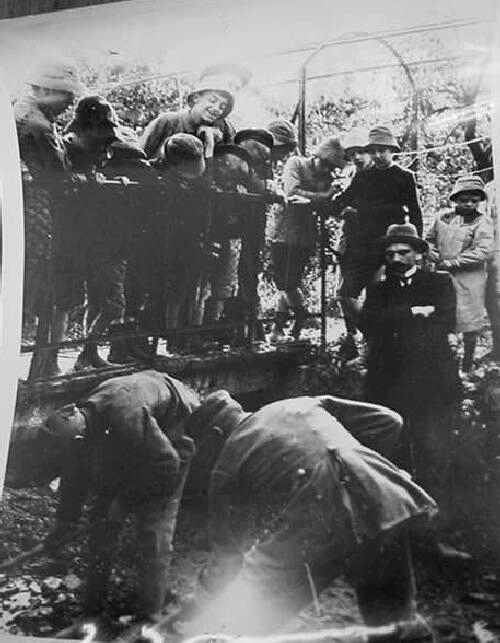
World War I: Prisoners of War (POWS)

Figure 1.--This press photo shows French civilians watching German POWs put to work in 1918. The caption read, "You laughed first ... Now we're laughing." The German POWs here are doing road work while French youngsters jeer their efforts. Source: International Film Service. Unfortunately our copy of the image is bent.
|
|
Fighting between Austria and Serboa began first (August 1914). This soon spiraled into a general European war when Germany invaded Belgium (August 1914). World War was the largest war fought in Europe up to that time. The major combatants soon found themselves with large numbers of prioners of war (POWS). The Germans took many French, Belgian, and Russian POWS. The British and French began taking Gernan prisoners as the BEF expanded into a major force. The Russians on the Eastern Front took fewer German prisoners, but quite a number of Austria-Hungargary prisoners. Turkey (1914), Bulgaria (1915), Italy (1915), and Romania (1916)subsequently entered the War. The Central Powers overan Serbia and Romania taking many POWS and releasing the POWS held by both countries. Russia quit the War and returned large numbers of POWS. America entered the War late and thus few Americans were captured, but took a number of Germans POWs. Generally these prisoners were treated correctly by the major combatants. The widespread attrocities commited in World War II did not occur in World War I. The behavior of Germany, Japan, and Russia, in sharp contrast to World War II, was generally correct. There were, however, some exceptions. The Austrians were very harsh with the Serbians, although we have few details. The Ottomans seem to have been the worst offenders. The Aran irregulars usually did not tale prisoners. The International Committee of the Red Cross (ICRS) initiated a major effort to address the POW problem and opened an office in Geneva for thos purpose (October 1914). Conbatant countries reported almost 5 million POWs to the ICRC. The ICC visited many of the prisoners and set up a system for families to send letters and relief parcels.
HBC

Navigate the Boys' Historical Clothing Web Site:
[Return to Main World War I People page]
[Return to Main World War I page]
[Introduction]
[Activities]
[Biographies]
[Chronology]
[Clothing styles]
[Countries]
[Bibliographies]
[Contributions]
[Essays]
[FAQs]
[Glossaries]
[Satellites]
[Tools]
[Boys' Clothing Home]
Created: 4:43 AM 12/11/2006
Last updated: 4:43 AM 12/11/2006



